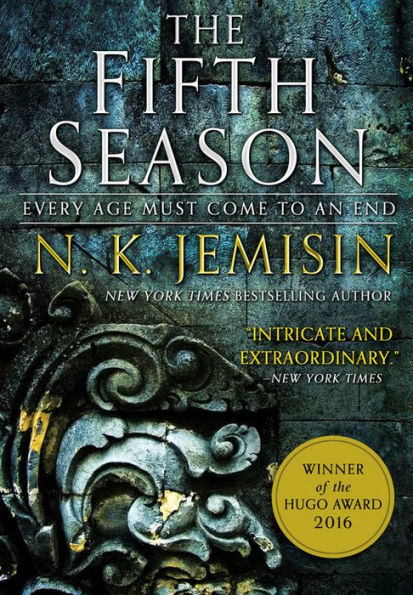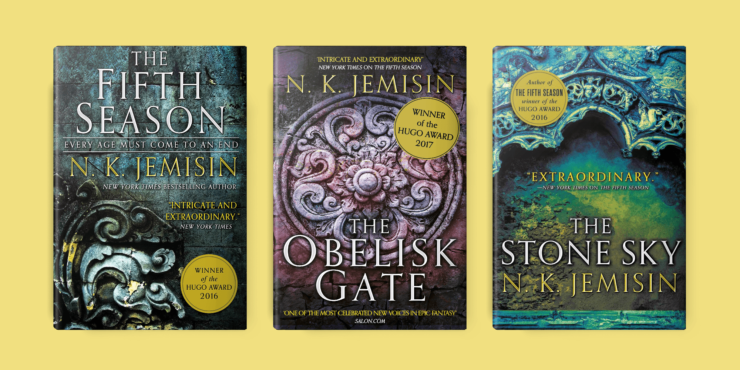The Broken Earth trilogy tells the story of Essun, a woman who possesses the power of orogeny, giving her the ability to manipulate the earth itself to stop earthquakes, among other things. Each of the three volumes of the trilogy—The Fifth Season (2015), The Obelisk Gate (2016), and The Stone Sky (2017)—deservedly won the Hugo Award for Best Novel in an unprecedented run.
The story opens with a man tearing the world apart, opening a massive rift in the earth and wiping out the capital…and triggering a volcanic winter that could last for millennia. Around the same time, Essun discovers that her husband has killed her son and stolen her daughter away because the children are both orogenes. She sets out on the road, following them, as the volcanic ash from the Rifting begins to fall.
Orogenes are feared by the public because they can be dangerous if untrained. Their power draws from the earth, and, if they aren’t careful, they can turn everyone and everything around them to ice. When orogenes are found “in the wild,” they are taken to the Fulcrum (if they’re young enough), where the children are trained to harness their power and use it more or less safely. Fulcrum orogenes are hired to quell quakes and other troublesome phenomena, so while they are feared and treated as unwanted outsiders, they’re considered a necessary evil. If an orogenic child is found too late, or if a Guardian from the Fulcrum doesn’t get to them in time, the child is usually killed—either out of fear, or as an act of revenge (seen as “justice”) for their accidental “icing” of someone who threatened them.
Why do they need people to quell earthquakes, and what’s a fifth season? The Earth itself is angry at humanity, and this triggers quakes and volcanoes, and other things. After one of these disasters, a fifth season begins: “All things change during a Season,” including the rules about how to live.
Buy the Book


The Fifth Season
Jemisin has constructed a believable idiom for the characters. The setting is heavily focused on the Earth and on stones, and a lot of their curses and exclamations of anger and frustration stem from these. One of the most frequent curses is “evil Earth,” which reflects the malice the Earth holds for them. Others include “oh, Earth,” and “rusting Earth.”
“Rust,” “rusting,” and “ruster” serve a similar purpose to the most versatile four-letter swear word in English (fuck). The characters could have said, for example, “bloody hell,” but they say, instead, “rusting Earth.” This is a very nice touch, because rust is oxidized iron, and it has become weak and won’t hold up to strain.
Expressions like “Fire under Earth!” and “earthfire!” refer to volcanoes and magma, which caused multiple Seasons, and thus denote bad things.
Orogenes call non-orogenes “stills” because they can’t feel the vibrations of the earth. Stills call orogenes “roggas” as a shortened form of orogene that’s used as a slur. It also sounds kind of like “rock.” One orogene later in the series reclaims the word and proudly calls herself a rogga.
Another example of the rock-themed idiom is the names of the Fulcrum-trained orogenes. They all have names of rocks: Alabaster, Syenite, Feldspar, Jasper. Orogenes born outside the Fulcrum choose their own name when they reach a certain level. I’m not sure whether Fulcrum-born orogenes choose their names or are given them, and I don’t remember it being in the book. (It’s possible that it was mentioned, and I forgot.) Corundum was named by his parents, but the circumstances of his birth were non-standard.
As you’d expect, the residents of the Stillness—named that in irony, naturally—have a set of vocabulary for things that are important to their society: “Orogenes,” obviously, and “fifth season,” but there are also words for other aspects of their lives.
“Sessapinae” are the organs near the brainstem that allow orogenes to sense quakes, which is referred to as “sessing,” as in “I sessed a quake. It was a niner.” Which leads us to the way orogenes refer to quakes: by a scale similar to the Richter scale, but without that name or technology. They don’t say “that was a seven point three,” but “a sevener.”
“Stonelore” is the set of rules handed down for generations that tell “comms” what to do in a Season. The original stonelore, or the oldest example the narrator knows of, was on stone, and things that are on stone are permanent. People shortened community to comm, and people who are outside a comm at the start of a Season are “commless” and “ashed out.”
The people of the Stillness live in regions that are named based on their latitude. The Arctics and Antarctics, Nomidlats and Somidlats, and Equatorials. Nomidlats is a shortening of “northern mid latitudes,” and correspondingly, Somidlats is short for “southern mid latitudes.” People from these two regions are called “Midlatters.”
The sciences in the Stillness are called, for example, geomestry and biomestry, which, as the reader later learns, are reduced forms of “geomagestry” and “biomagestry.” The suffix -magestry reminds me both of magic/mage and magister, and I can’t say for sure which was intended. In context, it could really be either.
The Broken Earth trilogy provides a great example of an author taking extra steps to create an idiom for their characters that reflects their society and its major concerns. It adds greater depth to what is already strong writing and a compelling story.
What did you think of the books, and the way Jemisin incorporates language into the story? Did the little linguistic touches add anything for you when you read it, or did you not really notice because it’s SFF so you went along with the overall worldbuilding? Share your thoughts in the comments!
CD Covington has masters degrees in German and Linguistics, likes science fiction and roller derby, and misses having a cat. She is a graduate of Viable Paradise 17 and has published short stories in anthologies, most recently the story “Debridement” in Survivor, edited by Mary Anne Mohanraj and J.J. Pionke.










